Global API Banking Market Forecast
- Global valuation of API banking market to leapfrog from US$24.5 Bn attained in 2022 to US$118.1 Bn in 2030
- API banking market size likely to experience a stellar CAGR of 25.2% between 2023 and 2030
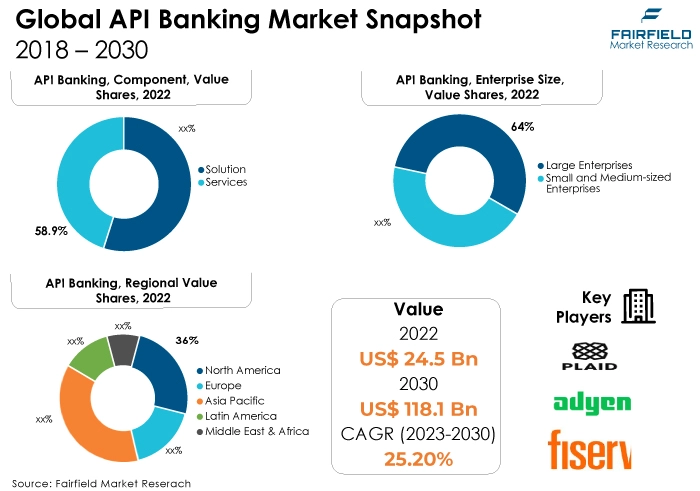
Quick Report Digest
- The key trend anticipated to fuel the global API banking market growth is the increasing popularity of banking applications.
- API banking market solution components, including API management platforms and developer tools, lead the API banking market due to their pivotal role in enabling seamless integration, customisation, and management of APIs. They cater to diverse financial services and bolster ecosystem development.
- On-premise deployment holds the largest API banking market share due to its robust data control and security features. Financial institutions often favour on-premise solutions to maintain control over sensitive data and ensure compliance with strict regulations.
- Individual end-users captured the largest market share in the API banking market because the concept of API banking planning is often a personal endeavor. Individuals across age groups recognize the importance of preserving their digital assets, driving widespread adoption of API Banking solutions.
- Large enterprises dominate the API banking market due to their resources and customer bases. They invest in comprehensive API solutions, manage complex ecosystems, and leverage established trust to expand their offerings, securing the largest market share.
- North America dominates the API banking market because of its well-established financial industry, strong technological infrastructure, and open banking initiatives. Large banks and fintech firms drive adoption, with regulatory support further boosting market leadership.
- The Asia Pacific region experiences the highest CAGR in the API banking market due to its rapid digitalisation, expanding fintech industry, government support for open banking, and a tech-savvy population, driving increased demand for API-based financial services and solutions.
- Regulatory changes and evolving customer expectations will continue to drive demand for secure and efficient API solutions, making the market a dynamic and promising sector in the financial industry.
A Look Back and a Look Forward - Comparative Analysis
The API market is experiencing robust growth due to increasing digitisation, demand for seamless data exchange, and the adoption of open banking initiatives. APIs enable real-time connectivity, fostering innovation in various industries, including finance, healthcare, and e-commerce.
As businesses seek to enhance customer experiences and streamline operations, the API market expands to cater to these needs, providing the foundation for data sharing, integration, and collaboration across a wide range of applications and services.
The API banking market is growing due to several factors. It enhances digital banking experiences, offering real-time data access and enabling seamless transactions. Second, it fosters innovation, allowing fintech firms to develop new financial products and services.
Regulatory initiatives like PSD2 in Europe are driving banks to open their APIs, promoting competition. Lastly, increased demand for mobile and online banking services is propelling the adoption of API technology in the financial sector.
The future of the API banking market holds immense growth opportunities as digital transformation intensifies. These opportunities include further integration of fintech innovations, expansion of open banking initiatives globally, and the development of specialised APIs for emerging technologies like blockchain and lot.
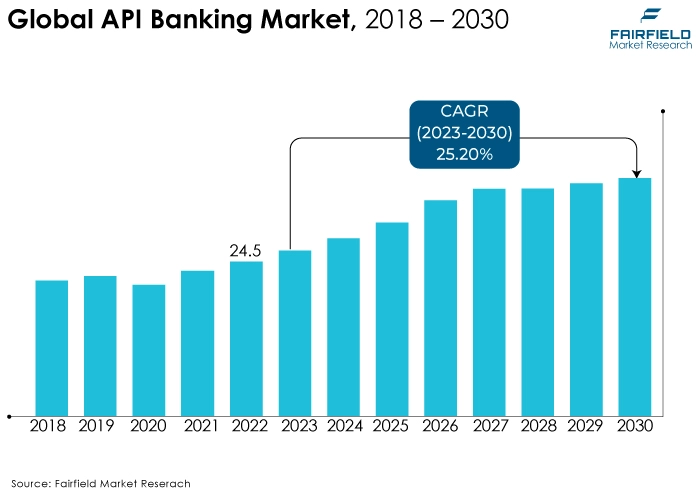
Key Growth Determinants
- Notable Rise in Open Banking Initiatives
Open banking initiatives are propelling the application programming interface (API) banking market by fostering greater collaboration and innovation in the financial sector. These initiatives require traditional banks to open up their data and systems through APIs, enabling third-party developers to create new financial services and applications. This promotes competition and offers consumers more choices.
API banking is thus experiencing substantial growth as banks seek to comply with open banking regulations and engage in partnerships with fintech firms. The use of APIs streamlines payment processes, enhances financial transparency, and enables the creation of innovative solutions like payment apps, budgeting tools, and lending platforms, driving the expansion of the API banking market.
- Digital Transformation, and Emphasis on Customer Experience
Digital transformation and customer experience are pivotal drivers of the API banking market. Banks are increasingly adopting APIs to modernize their operations, enhance agility, and meet customer expectations for seamless digital services. APIs enable faster, more efficient transactions, real-time data access, and personalised banking experiences.
By offering integrated solutions, improved accessibility, and innovative fintech partnerships, banks can elevate customer satisfaction and competitiveness. This heightened focus on digital transformation and superior customer experiences is propelling the growth of API banking as it becomes integral to modern banking services.
- Enhanced Security and Compliance
Enhanced security and compliance are significant drivers of the API banking market. As financial transactions increasingly rely on APIs, robust security measures are essential to protect sensitive data. Banks are investing in secure API technologies to meet stringent regulatory requirements such as PSD2, and GDPR.
Compliance with these standards builds trust with customers and partners, facilitating seamless data sharing while safeguarding against cyber threats. The emphasis on security and compliance is driving the adoption of API banking solutions, ensuring the safe and efficient exchange of financial information.
Major Growth Barriers
- Complex Legal Landscape
Regulatory compliance presents challenges to the API banking market. Financial institutions must adhere to a complex web of regulations and standards, such as PSD2, GDPR, and KYC/AML requirements, which vary by region.
Ensuring API data security, privacy, and consent management while complying with these rules demands significant investments in technology and resources. Achieving interoperability among diverse systems and standards poses further difficulties.
Navigating this intricate compliance landscape while fostering innovation and maintaining a competitive edge is a key challenge facing the API banking sector.
- Security Concerns
Security concerns pose a significant challenge to the API banking market. With the increasing reliance on APIs for financial transactions, the risk of cyberattacks and data breaches is heightened. Ensuring robust authentication, encryption, and access controls is imperative.
API endpoints can be vulnerable, and banks must continually monitor and patch vulnerabilities. Additionally, the complexity of securing APIs across various platforms and partners adds to the challenge. Maintaining the integrity and confidentiality of financial data is paramount, making security a top priority in the API banking sector.
Key Trends and Opportunities to Look at
- Growing API security
API security technology in the API banking market focuses on safeguarding sensitive financial data and preventing unauthorised access. It includes measures like Auth for secure authorisation, API gateways for traffic control and monitoring, encryption for data protection, and tokenisation for secure data exchange.
API security solutions also incorporate threat detection, real-time monitoring, and access controls to mitigate cybersecurity risks and ensure compliance with regulatory standards.
- Increasing Cloud Integration
Cloud integration technology in the API banking market enables seamless connectivity and data exchange between financial institutions, third-party providers, and customers.
It leverages cloud-based platforms to enhance scalability, agility, and cost-effectiveness. This technology enables banks to efficiently manage and deploy APIs, ensuring real-time access to financial services, data, and applications across various channels.
Cloud integration simplifies API deployment, management, and updates, facilitating a more responsive and connected banking ecosystem.
- Rising Adoption of Aartificial Intelligence, and Machine Learning
Al, and Machine Learning are transforming the API banking market by enhancing operational efficiency, risk management, and customer experience. Al-powered algorithms analyze transaction data to detect anomalies and fraud. ML models offer personalised financial recommendations and insights.
Chatbots powered by Al provide responsive customer support. Al, and ML also optimize API performance and cybersecurity, making banking services more intelligent, secure, and user-friendly.
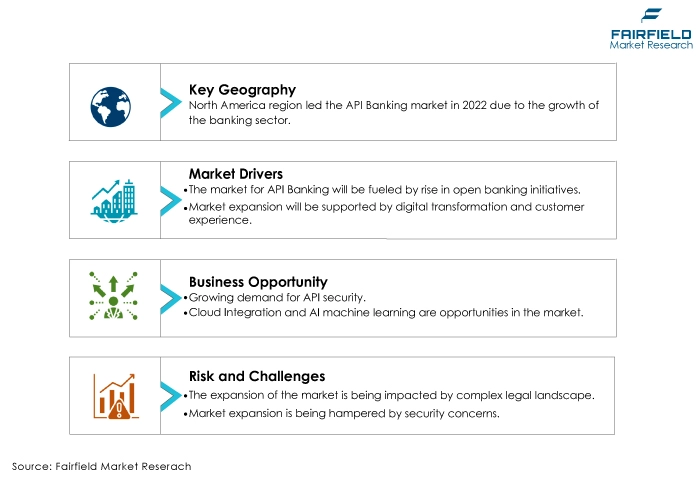
How Does the Regulatory Scenario Shape this Industry?
The regulatory landscape significantly influences the API banking market by defining the rules and standards that financial institutions must follow when adopting APIs. Open banking regulations, such as PSD2 in Europe and similar initiatives in other regions, mandate that banks provide access to customer data and payment services through APIs to licensed third-party providers. These regulations promote competition, innovation, and consumer choice while ensuring data security and privacy.
Additionally, data protection regulations like GDPR require stringent measures to safeguard customer data when sharing it via APIs. Financial institutions must implement robust consent management and data protection mechanisms, impacting API design and implementation. Compliance with these regulations is not only mandatory but also crucial for maintaining customer trust and avoiding hefty fines.
Moreover, regulators are continuously evolving the API landscape, introducing new standards and requirements. Financial institutions must stay agile and adapt to changing regulations, impacting their API strategies and investments. In summary, the regulatory landscape plays a pivotal role in shaping the API banking market by driving standardisation, security, and competition while requiring ongoing compliance and adaptation from industry participants.
Fairfield’s Ranking Board
Top Segments
- Solutions will be the Dominant Component Category
Solution components, such as API management platforms, authentication and authorisation tools, and developer support systems, have captured the largest market share in the API banking sector due to their essential role in enabling seamless API integration and management. Banks and financial institutions rely on these components to provide secure, efficient, and scalable API services.
In addition, as API adoption continues to grow, the demand for comprehensive solutions that encompass these components drives their dominance in the market, facilitating robust API banking ecosystems.
The services component is experiencing the highest growth rate in the API banking market because financial institutions increasingly seek specialised services to design, implement, and manage their APIs. These services include API consulting, integration, customisation, and support. As the complexity of APIs and regulatory requirements rise, banks turn to third-party providers for expertise.
Moreover, API services facilitate rapid deployment and reduce time-to-market for new financial products and services, driving their rapid adoption and growth in the market.
- On-Premise Deployment Mode Most Preferred
On-premise deployment mode has secured the largest market share in the API banking sector due to stringent security and data control requirements in the financial industry. Banks and financial institutions often prefer on-premise solutions to maintain control over sensitive customer data and ensure compliance with strict regulatory standards. It allows them to customize and secure their API infrastructure while meeting internal policies.
While cloud-based options are growing, the demand for on-premise solutions persists, contributing to its market dominance. Cloud deployment is experiencing the highest growth rate in the API banking market because it offers scalability, agility, and cost-effectiveness.
Cloud-based solutions enable financial institutions to adapt to evolving customer demands and regulatory changes quickly. They reduce infrastructure costs, promote faster time-to-market for new services, and facilitate easier collaboration with third-party developers. As the industry embraces digital transformation and the need for flexibility increases, cloud deployment becomes a preferred choice, fueling its rapid growth in the API banking sector.
- Large Enterprises Continue to Surge Ahead
Large enterprises have dominated the API banking market due to their extensive resources and established customer bases. They can invest in comprehensive API solutions and infrastructure to support their diverse financial services.
Large banks can develop and manage complex API ecosystems, ensuring seamless integration with legacy systems. Additionally, their well-established reputation and customer trust enable them to expand their API offerings more easily, consolidating their hold on the market's largest share.
Small and medium enterprises (SMEs) are experiencing the highest growth rate in the API banking market due to their agility and adaptability. SMEs often adopt innovative financial solutions more swiftly than larger institutions. They leverage APIs to enhance their services, reduce operational costs, and expand their digital offerings.
Additionally, API providers increasingly cater to the specific needs of SMEs with scalable and cost-effective solutions, making API banking accessible and attractive to this sector and fuelling its rapid growth.
Regional Frontrunners
North America at the Top
North America has secured the largest market share in the API banking sector for several reasons. The region is home to a robust financial services industry with a high degree of technological adoption. Large-scale banks and financial institutions in North America have heavily invested in API banking to enhance customer experiences and streamline operations.
The regulatory environment, particularly in the United States, has encouraged the implementation of open banking initiatives, driving API adoption. Additionally, North America boasts a thriving fintech ecosystem, fostering collaboration between traditional financial institutions and tech startups, further propelling API banking growth.
The region's strong emphasis on cybersecurity and data privacy aligns with the security requirements of API banking, boosting its market dominance.
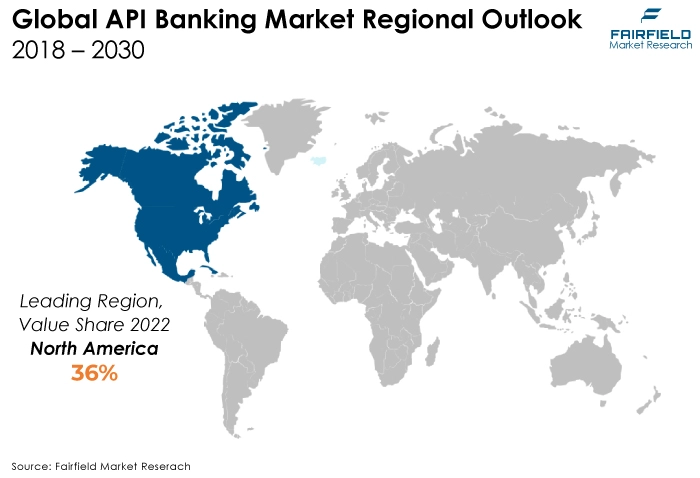
Asia Pacific Awaits Exceptional Growth Prospects
Rapid economic growth, increasing digitalisation, and a burgeoning fintech landscape are driving demand for API-based financial services. Governments in the region are also promoting open banking initiatives and digital transformation, further accelerating API adoption.
Additionally, the large, tech-savvy population in countries like India and China is embracing digital banking, contributing to the robust growth of API banking in the Asia Pacific.
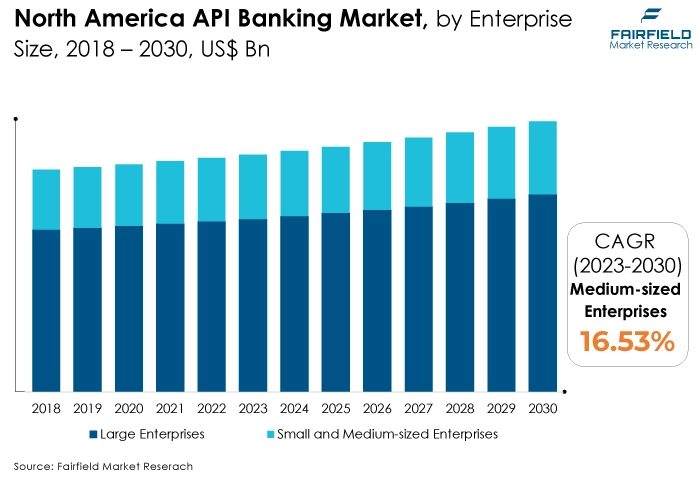
Fairfield’s Competitive Landscape Analysis
The global API banking market is a consolidated market with fewer major players present globally. The key players are introducing new products and working on the distribution channels to enhance their worldwide presence. Moreover, Fairfield Market Research expects more consolidation over the coming years.
Who are the Leaders in the Global API Banking Market space?
- Plaid
- Yodlee
- Finbox
- Xignite
- Quandl
- Fiserv
- Finastra
- MX
- Tink
- Open Bank Project
- Adyen
- Stripe
- Twilio
- Amazon Web Services (AWS)
- Microsoft Azure
Significant Company Developments
New Product Launches
- January 2022: The API banking market is set for continuous growth and rising demand. With businesses giving preference to digitalisation, the requirement for secure, flexible, and interconnected financial services via APIs is expected to keep increasing. The expansion of fintech ecosystems and compliance with open banking regulations will further propel the growth of the market. Anticipated demand will be driven by the pursuit of creative financial solutions, seamless customer experiences, and enhanced operational efficiency, solidifying API banking as a crucial element in the financial industry's future.
- March 2022: Kyash, a mobile finance software company headquartered in Tokyo, secured USD 41.2 million in Series D funding (4.9 billion JPY). This round of investment saw participation from various investors, including Japan Post Investment Corporation, Block (formerly Square), Greyhound Capital, SMBC Nikko Securities, Altos Ventures, Goodwater Capital, StepStone Group, JAFCO Group, Mitsui Sumitomo Insurance Capital, along with others.
Distribution Agreement
- January 2023: Aspire Systems recently achieved the status of an AWS Advanced Consulting Partner, enabling the company to enhance its cloud solutions with AWS resources. This partnership allows Aspire to assist government and space agencies, educational institutions, and nonprofit organisations. Leveraging insights gained from the coveted APN Immersion Days, Aspire delivers unique, cutting-edge AWS solutions to its clients.
An Expert’s Eye
Demand and Future Growth
As per Fairfield’s Analysis, growth in banking sector is driving the market. The API banking market is poised for sustained growth and increasing demand. As businesses prioritize digitalisation, the need for secure, agile, and interconnected financial services through APIs will continue to rise.
Open banking regulations and expanding fintech ecosystems will further drive market growth. Future demand will be fueled by the quest for innovative financial solutions, seamless customer experiences, and improved operational efficiency, making API banking a vital component of the financial industry's future.
Supply Side of the Market
The leading countries in the API banking market were the United States, the United Kingdom, India, Singapore, and Australia. These nations had robust ecosystems of financial institutions, fintech companies, and technology infrastructure that fostered the development and adoption of API banking solutions.
However, the landscape can change rapidly due to regulatory changes, technological advancements, and market dynamics. So, it's essential to consult up-to-date sources for the latest information on the leading countries in the API banking market in 2023.
The API banking market primarily relies on digital infrastructure, software development tools, and secure communication protocols rather than traditional raw materials. Key components include data centres, cloud computing resources, cybersecurity solutions, and development frameworks.
Major suppliers of these resources include Amazon Web Services (AWS), Microsoft Azure, Google Cloud, IBM Cloud, and Oracle Cloud for cloud infrastructure. Additionally, cybersecurity providers like Palo Alto Networks, Cisco, and Fortinet play a crucial role in securing API transactions.
Development frameworks and tools are often open-source, with contributors from various organisations worldwide, making it challenging to pinpoint specific suppliers.
Global Global API Banking Market is Segmented as Below:
By Component:
- Solution
- Service
By Deployment:
- On-premise
- Cloud
By Enterprise Size:
- Large Enterprises
- Small and Medium-sized Enterprises
By Geographic Coverage:
- North America
- The U.S.
- Canada
- Europe
- Germany
- U.K.
- France
- Italy
- Turkey
- Russia
- Rest of Europe
- Asia Pacific
- China
- Japan
- South Korea
- India
- Southeast Asia
- Rest of Asia Pacific
- Latin America
- Brazil
- Mexico
- Argentina
- Rest of Latin America
- Middle East & Africa
- GCC
- South Africa
- Egypt
- Nigeria
- Rest of the Middle East & Africa
1. Executive Summary
1.1. Global API Banking Market Snapshot
1.2. Future Projections
1.3. Key Market Trends
1.4. Regional Snapshot, by Value, 2022
1.5. Analyst Recommendations
2. Market Overview
2.1. Market Definitions and Segmentations
2.2. Market Dynamics
2.2.1. Drivers
2.2.2. Restraints
2.2.3. Market Opportunities
2.3. Value Chain Analysis
2.4. Porter’s Five Forces Analysis
2.5. Covid-19 Impact Analysis
2.5.1. Supply
2.5.2. Demand
2.6. Impact of Ukraine-Russia Conflict
2.7. Economic Overview
2.7.1. World Economic Projections
2.8. PESTLE Analysis
3. Global API Banking Market Outlook, 2018 - 2030
3.1. Global API Banking Market Outlook, by Component, Value (US$ Bn), 2018 - 2030
3.1.1. Key Highlights
3.1.1.1. Solution
3.1.1.2. Service
3.2. Global API Banking Market Outlook, by Deployment, Value (US$ Bn), 2018 - 2030
3.2.1. Key Highlights
3.2.1.1. On-premise
3.2.1.2. Cloud
3.3. Global API Banking Market Outlook, by Enterprise Size, Value (US$ Bn), 2018 - 2030
3.3.1. Key Highlights
3.3.1.1. Large Enterprises
3.3.1.2. Small and Medium-sized Enterprises
3.4. Global API Banking Market Outlook, by Region, Value (US$ Bn), 2018 - 2030
3.4.1. Key Highlights
3.4.1.1. North America
3.4.1.2. Europe
3.4.1.3. Asia Pacific
3.4.1.4. Latin America
3.4.1.5. Middle East & Africa
4. North America API Banking Market Outlook, 2018 - 2030
4.1. North America API Banking Market Outlook, by Component, Value (US$ Bn), 2018 - 2030
4.1.1. Key Highlights
4.1.1.1. Solution
4.1.1.2. Service
4.2. North America API Banking Market Outlook, by Deployment, Value (US$ Bn), 2018 - 2030
4.2.1. Key Highlights
4.2.1.1. On-premise
4.2.1.2. Cloud
4.3. North America API Banking Market Outlook, by Enterprise Size, Value (US$ Bn), 2018 - 2030
4.3.1. Key Highlights
4.3.1.1. Large Enterprises
4.3.1.2. Small and Medium-sized Enterprises
4.3.2. BPS Analysis/Market Attractiveness Analysis
4.4. North America API Banking Market Outlook, by Country, Value (US$ Bn), 2018 - 2030
4.4.1. Key Highlights
4.4.1.1. U.S. API Banking Market by Component, Value (US$ Bn), 2018 - 2030
4.4.1.2. U.S. API Banking Market Deployment, Value (US$ Bn), 2018 - 2030
4.4.1.3. U.S. API Banking Market Enterprise Size, Value (US$ Bn), 2018 - 2030
4.4.1.4. U.S. API Banking Market End Use, Value (US$ Bn), 2018 - 2030
4.4.1.5. Canada API Banking Market by Component, Value (US$ Bn), 2018 - 2030
4.4.1.6. Canada API Banking Market Deployment, Value (US$ Bn), 2018 - 2030
4.4.1.7. Canada API Banking Market Enterprise Size, Value (US$ Bn), 2018 - 2030
4.4.1.8. Canada API Banking Market End Use, Value (US$ Bn), 2018 - 2030
4.4.2. BPS Analysis/Market Attractiveness Analysis
5. Europe API Banking Market Outlook, 2018 - 2030
5.1. Europe API Banking Market Outlook, by Component, Value (US$ Bn), 2018 - 2030
5.1.1. Key Highlights
5.1.1.1. Solution
5.1.1.2. Service
5.2. Europe API Banking Market Outlook, by Deployment, Value (US$ Bn), 2018 - 2030
5.2.1. Key Highlights
5.2.1.1. On-premise
5.2.1.2. Cloud
5.3. Europe API Banking Market Outlook, by Enterprise Size, Value (US$ Bn), 2018 - 2030
5.3.1. Key Highlights
5.3.1.1. Large Enterprises
5.3.1.2. Small and Medium-sized Enterprises
5.3.2. BPS Analysis/Market Attractiveness Analysis
5.4. Europe API Banking Market Outlook, by Country, Value (US$ Bn), 2018 - 2030
5.4.1. Key Highlights
5.4.1.1. Germany API Banking Market by Component, Value (US$ Bn), 2018 - 2030
5.4.1.2. Germany API Banking Market Deployment, Value (US$ Bn), 2018 - 2030
5.4.1.3. Germany API Banking Market Enterprise Size, Value (US$ Bn), 2018 - 2030
5.4.1.4. U.K. API Banking Market by Component, Value (US$ Bn), 2018 - 2030
5.4.1.5. U.K. API Banking Market Deployment, Value (US$ Bn), 2018 - 2030
5.4.1.6. U.K. API Banking Market Enterprise Size, Value (US$ Bn), 2018 - 2030
5.4.1.7. France API Banking Market by Component, Value (US$ Bn), 2018 - 2030
5.4.1.8. France API Banking Market Deployment, Value (US$ Bn), 2018 - 2030
5.4.1.9. France API Banking Market Enterprise Size, Value (US$ Bn), 2018 - 2030
5.4.1.10. Italy API Banking Market by Component, Value (US$ Bn), 2018 - 2030
5.4.1.11. Italy API Banking Market Deployment, Value (US$ Bn), 2018 - 2030
5.4.1.12. Italy API Banking Market Enterprise Size, Value (US$ Bn), 2018 - 2030
5.4.1.13. Turkey API Banking Market by Component, Value (US$ Bn), 2018 - 2030
5.4.1.14. Turkey API Banking Market Deployment, Value (US$ Bn), 2018 - 2030
5.4.1.15. Turkey API Banking Market Enterprise Size, Value (US$ Bn), 2018 - 2030
5.4.1.16. Russia API Banking Market by Component, Value (US$ Bn), 2018 - 2030
5.4.1.17. Russia API Banking Market Deployment, Value (US$ Bn), 2018 - 2030
5.4.1.18. Russia API Banking Market Enterprise Size, Value (US$ Bn), 2018 - 2030
5.4.1.19. Rest of Europe API Banking Market by Component, Value (US$ Bn), 2018 - 2030
5.4.1.20. Rest of Europe API Banking Market Deployment, Value (US$ Bn), 2018 - 2030
5.4.1.21. Rest of Europe API Banking Market Enterprise Size, Value (US$ Bn), 2018 - 2030
5.4.2. BPS Analysis/Market Attractiveness Analysis
6. Asia Pacific API Banking Market Outlook, 2018 - 2030
6.1. Asia Pacific API Banking Market Outlook, by Component, Value (US$ Bn), 2018 - 2030
6.1.1. Key Highlights
6.1.1.1. Solution
6.1.1.2. Service
6.2. Asia Pacific API Banking Market Outlook, by Deployment, Value (US$ Bn), 2018 - 2030
6.2.1. Key Highlights
6.2.1.1. On-premise
6.2.1.2. Cloud
6.3. Asia Pacific API Banking Market Outlook, by Enterprise Size, Value (US$ Bn), 2018 - 2030
6.3.1. Key Highlights
6.3.1.1. Large Enterprises
6.3.1.2. Small and Medium-sized Enterprises
6.3.2. BPS Analysis/Market Attractiveness Analysis
6.4. Asia Pacific API Banking Market Outlook, by Country, Value (US$ Bn), 2018 - 2030
6.4.1. Key Highlights
6.4.1.1. China API Banking Market by Component, Value (US$ Bn), 2018 - 2030
6.4.1.2. China API Banking Market Deployment, Value (US$ Bn), 2018 - 2030
6.4.1.3. China API Banking Market Enterprise Size, Value (US$ Bn), 2018 - 2030
6.4.1.4. Japan API Banking Market by Component, Value (US$ Bn), 2018 - 2030
6.4.1.5. Japan API Banking Market Deployment, Value (US$ Bn), 2018 - 2030
6.4.1.6. Japan API Banking Market Enterprise Size, Value (US$ Bn), 2018 - 2030
6.4.1.7. South Korea API Banking Market by Component, Value (US$ Bn), 2018 - 2030
6.4.1.8. South Korea API Banking Market Deployment, Value (US$ Bn), 2018 - 2030
6.4.1.9. South Korea API Banking Market Enterprise Size, Value (US$ Bn), 2018 - 2030
6.4.1.10. India API Banking Market by Component, Value (US$ Bn), 2018 - 2030
6.4.1.11. India API Banking Market Deployment, Value (US$ Bn), 2018 - 2030
6.4.1.12. India API Banking Market Enterprise Size, Value (US$ Bn), 2018 - 2030
6.4.1.13. Southeast Asia API Banking Market by Component, Value (US$ Bn), 2018 - 2030
6.4.1.14. Southeast Asia API Banking Market Deployment, Value (US$ Bn), 2018 - 2030
6.4.1.15. Southeast Asia API Banking Market Enterprise Size, Value (US$ Bn), 2018 - 2030
6.4.1.16. Rest of Asia Pacific API Banking Market by Component, Value (US$ Bn), 2018 - 2030
6.4.1.17. Rest of Asia Pacific API Banking Market Deployment, Value (US$ Bn), 2018 - 2030
6.4.1.18. Rest of Asia Pacific API Banking Market Enterprise Size, Value (US$ Bn), 2018 - 2030
6.4.2. BPS Analysis/Market Attractiveness Analysis
7. Latin America API Banking Market Outlook, 2018 - 2030
7.1. Latin America API Banking Market Outlook, by Component, Value (US$ Bn), 2018 - 2030
7.1.1. Key Highlights
7.1.1.1. Solution
7.1.1.2. Service
7.2. Latin America API Banking Market Outlook, by Deployment, Value (US$ Bn), 2018 - 2030
7.2.1. Key Highlights
7.2.1.1. On-premise
7.2.1.2. Cloud
7.3. Latin America API Banking Market Outlook, by Enterprise Size, Value (US$ Bn), 2018 - 2030
7.3.1. Key Highlights
7.3.1.1. Large Enterprises
7.3.1.2. Small and Medium-sized Enterprises
7.3.2. BPS Analysis/Market Attractiveness Analysis
7.4. Latin America API Banking Market Outlook, by Country, Value (US$ Bn), 2018 - 2030
7.4.1. Key Highlights
7.4.1.1. Brazil API Banking Market by Component, Value (US$ Bn), 2018 - 2030
7.4.1.2. Brazil API Banking Market Deployment, Value (US$ Bn), 2018 - 2030
7.4.1.3. Brazil API Banking Market Enterprise Size, Value (US$ Bn), 2018 - 2030
7.4.1.4. Mexico API Banking Market by Component, Value (US$ Bn), 2018 - 2030
7.4.1.5. Mexico API Banking Market Deployment, Value (US$ Bn), 2018 - 2030
7.4.1.6. Mexico API Banking Market Enterprise Size, Value (US$ Bn), 2018 - 2030
7.4.1.7. Argentina API Banking Market by Component, Value (US$ Bn), 2018 - 2030
7.4.1.8. Argentina API Banking Market Deployment, Value (US$ Bn), 2018 - 2030
7.4.1.9. Argentina API Banking Market Enterprise Size, Value (US$ Bn), 2018 - 2030
7.4.1.10. Rest of Latin America API Banking Market by Component, Value (US$ Bn), 2018 - 2030
7.4.1.11. Rest of Latin America API Banking Market Deployment, Value (US$ Bn), 2018 - 2030
7.4.1.12. Rest of Latin America API Banking Market Enterprise Size, Value (US$ Bn), 2018 - 2030
7.4.2. BPS Analysis/Market Attractiveness Analysis
8. Middle East & Africa API Banking Market Outlook, 2018 - 2030
8.1. Middle East & Africa API Banking Market Outlook, by Component, Value (US$ Bn), 2018 - 2030
8.1.1. Key Highlights
8.1.1.1. Solution
8.1.1.2. Service
8.2. Middle East & Africa API Banking Market Outlook, by Deployment, Value (US$ Bn), 2018 - 2030
8.2.1. Key Highlights
8.2.1.1. On-premise
8.2.1.2. Cloud
8.3. Middle East & Africa API Banking Market Outlook, by Enterprise Size, Value (US$ Bn), 2018 - 2030
8.3.1. Key Highlights
8.3.1.1. Large Enterprises
8.3.1.2. Small and Medium-sized Enterprises
8.3.2. BPS Analysis/Market Attractiveness Analysis
8.4. Middle East & Africa API Banking Market Outlook, by Country, Value (US$ Bn), 2018 - 2030
8.4.1. Key Highlights
8.4.1.1. GCC API Banking Market by Component, Value (US$ Bn), 2018 - 2030
8.4.1.2. GCC API Banking Market Deployment, Value (US$ Bn), 2018 - 2030
8.4.1.3. GCC API Banking Market Enterprise Size, Value (US$ Bn), 2018 - 2030
8.4.1.4. South Africa API Banking Market by Component, Value (US$ Bn), 2018 - 2030
8.4.1.5. South Africa API Banking Market Deployment, Value (US$ Bn), 2018 - 2030
8.4.1.6. South Africa API Banking Market Enterprise Size, Value (US$ Bn), 2018 - 2030
8.4.1.7. Egypt API Banking Market by Component, Value (US$ Bn), 2018 - 2030
8.4.1.8. Egypt API Banking Market Deployment, Value (US$ Bn), 2018 - 2030
8.4.1.9. Egypt API Banking Market Enterprise Size, Value (US$ Bn), 2018 - 2030
8.4.1.10. Nigeria API Banking Market by Component, Value (US$ Bn), 2018 - 2030
8.4.1.11. Nigeria API Banking Market Deployment, Value (US$ Bn), 2018 - 2030
8.4.1.12. Nigeria API Banking Market Enterprise Size, Value (US$ Bn), 2018 - 2030
8.4.1.13. Rest of Middle East & Africa API Banking Market by Component, Value (US$ Bn), 2018 - 2030
8.4.1.14. Rest of Middle East & Africa API Banking Market Deployment, Value (US$ Bn), 2018 - 2030
8.4.1.15. Rest of Middle East & Africa API Banking Market Enterprise Size, Value (US$ Bn), 2018 - 2030
8.4.2. BPS Analysis/Market Attractiveness Analysis
9. Competitive Landscape
9.1. Enterprise Size vs Deployment Heatmap
9.2. Manufacturer vs Deployment Heatmap
9.3. Company Market Share Analysis, 2022
9.4. Competitive Dashboard
9.5. Company Profiles
9.5.1. Plaid
9.5.1.1. Company Overview
9.5.1.2. Product Portfolio
9.5.1.3. Financial Overview
9.5.1.4. Business Strategies and Development
9.5.2. Yodlee
9.5.2.1. Company Overview
9.5.2.2. Product Portfolio
9.5.2.3. Financial Overview
9.5.2.4. Business Strategies and Development
9.5.3. Finbox
9.5.3.1. Company Overview
9.5.3.2. Product Portfolio
9.5.3.3. Financial Overview
9.5.3.4. Business Strategies and Development
9.5.4. Xignite
9.5.4.1. Company Overview
9.5.4.2. Product Portfolio
9.5.4.3. Financial Overview
9.5.4.4. Business Strategies and Development
9.5.5. Quandl
9.5.5.1. Company Overview
9.5.5.2. Product Portfolio
9.5.5.3. Financial Overview
9.5.5.4. Business Strategies and Development
9.5.6. Fiserv
9.5.6.1. Company Overview
9.5.6.2. Product Portfolio
9.5.6.3. Financial Overview
9.5.6.4. Business Strategies and Development
9.5.7. Finastra
9.5.7.1. Company Overview
9.5.7.2. Product Portfolio
9.5.7.3. Financial Overview
9.5.7.4. Business Strategies and Development
9.5.8. MX
9.5.8.1. Company Overview
9.5.8.2. Product Portfolio
9.5.8.3. Financial Overview
9.5.8.4. Business Strategies and Development
9.5.9. Tink
9.5.9.1. Company Overview
9.5.9.2. Product Portfolio
9.5.9.3. Financial Overview
9.5.9.4. Business Strategies and Development
9.5.10. Open Bank Project
9.5.10.1. Company Overview
9.5.10.2. Product Portfolio
9.5.10.3. Financial Overview
9.5.10.4. Business Strategies and Development
9.5.11. Adyen
9.5.11.1. Company Overview
9.5.11.2. Product Portfolio
9.5.11.3. Financial Overview
9.5.11.4. Business Strategies and Development
9.5.12. Stripe
9.5.12.1. Company Overview
9.5.12.2. Product Portfolio
9.5.12.3. Financial Overview
9.5.12.4. Business Strategies and Development
9.5.13. Twilio
9.5.13.1. Company Overview
9.5.13.2. Product Portfolio
9.5.13.3. Financial Overview
9.5.13.4. Business Strategies and Development
9.5.14. Amazon Web Services (AWS)
9.5.14.1. Company Overview
9.5.14.2. Product Portfolio
9.5.14.3. Financial Overview
9.5.14.4. Business Strategies and Development
9.5.15. Microsoft Azure
9.5.15.1. Company Overview
9.5.15.2. Product Portfolio
9.5.15.3. Financial Overview
9.5.15.4. Business Strategies and Development
10. Appendix
10.1. Research Methodology
10.2. Report Assumptions
10.3. Acronyms and Abbreviations
|
BASE YEAR |
HISTORICAL DATA |
FORECAST PERIOD |
UNITS |
|||
|
2022 |
|
2018 - 2022 |
2023 - 2030 |
Value: US$ Million |
||
|
REPORT FEATURES |
DETAILS |
|
Component Coverage |
|
|
Deployment Coverage |
|
|
Enterprise Size Coverage |
|
|
Geographical Coverage |
|
|
Leading Companies |
|
|
Report Highlights |
Key Market Indicators, Macro-micro economic impact analysis, Technological Roadmap, Key Trends, Driver, Restraints, and Future Opportunities & Revenue Pockets, Porter’s 5 Forces Analysis, Historical Trend (2019-2021), Market Estimates and Forecast, Market Dynamics, Industry Trends, Competition Landscape, Category, Region, Country- wise Trends & Analysis, COVID-19 Impact Analysis (Demand and Supply Chain) |
